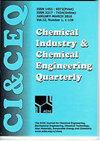Liquefied fuel from plastic wastes using nitro cracking method with refinery distillation bubble cap plate column
IF 0.8
4区 工程技术
Q4 CHEMISTRY, APPLIED
Chemical Industry & Chemical Engineering Quarterly
Pub Date : 2021-01-01
DOI:10.2298/CICEQ200907014S
引用次数: 1
Abstract
Development and modernization have resulted in an immense increase in the production of all kinds of goods, which indirectly produce waste to the globe. Plastic was one of the materials that produce more waste due to its wide range of applications due to its versatility and relatively low cost. In most cases, thermoplastics polymer makes up a high proportion of waste and steadily increasing worldwide pollution to the environment. As a result, waste plastics pose a severe environmental challenge due to their non-biodegradable properties and disposal problems. Diverse innovations are being developed to address plastic drawbacks, which can boost the profits of the recycling industry and shrink the world plastic waste landfills. As a part of recycling, the present work is aimed to produce liquefied fuel through the nitro cracking method using pyrolysis reactor induced with bubble cap plate column with Y zeolite as a catalyst. The liquefied fuel results produced from plastic wastes (plastics bags, plastic bottles, packing materials, and medical plastics) are compared with fuel produced from virgin plastics. The 8% higher pyrolytic oil yield is achieved compared with the results of oil produced without catalyst, and 82% of total waste plastic material is converted into liquefied fuel by the presence of a catalyst. FTIR, GC-MS, Bomb Calorimeter characterize the obtained fuel results by adopting the standard ASTM methods, and the results were compared with virgin and waste plastics.利用炼油厂蒸馏泡盖板塔硝基裂解法提取塑料废弃物液化燃料
发展和现代化导致了各种商品生产的大量增加,这间接地给地球带来了废物。塑料由于其多功能性和相对较低的成本,其应用范围广泛,是产生更多废物的材料之一。在大多数情况下,热塑性聚合物构成了很高比例的废物,并不断增加全球对环境的污染。因此,废塑料由于其不可生物降解的特性和处理问题,对环境构成了严峻的挑战。人们正在开发各种创新技术来解决塑料的缺点,这可以提高回收行业的利润,并缩小世界塑料垃圾填埋场。作为循环利用的一部分,本工作旨在以Y型沸石为催化剂,利用气泡帽板塔诱导热解反应器,通过硝化裂解法生产液化燃料。将从塑料废物(塑料袋、塑料瓶、包装材料和医用塑料)中产生的液化燃料与从原始塑料中产生的燃料进行比较。与无催化剂产油相比,热解油收率提高了8%,在催化剂的作用下,废塑料总量的82%转化为液化燃料。FTIR、GC-MS、Bomb量热仪采用标准ASTM方法对所得燃料结果进行表征,并将结果与生塑料和废塑料进行比较。
本文章由计算机程序翻译,如有差异,请以英文原文为准。
求助全文
约1分钟内获得全文
求助全文
来源期刊

Chemical Industry & Chemical Engineering Quarterly
CHEMISTRY, APPLIED-ENGINEERING, CHEMICAL
CiteScore
2.10
自引率
0.00%
发文量
24
审稿时长
3.3 months
期刊介绍:
The Journal invites contributions to the following two main areas:
• Applied Chemistry dealing with the application of basic chemical sciences to industry
• Chemical Engineering dealing with the chemical and biochemical conversion of raw materials into different products as well as the design and operation of plants and equipment.
The Journal welcomes contributions focused on:
Chemical and Biochemical Engineering [...]
Process Systems Engineering[...]
Environmental Chemical and Process Engineering[...]
Materials Synthesis and Processing[...]
Food and Bioproducts Processing[...]
Process Technology[...]
 求助内容:
求助内容: 应助结果提醒方式:
应助结果提醒方式:


